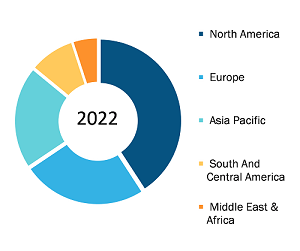The animal health market is projected to reach US$ 126,500.20 million by 2028; registering at a CAGR of 6.2% from 2022 to 2028, according to a new research study conducted by The Insight Partners
Rise in Demand for Proteinaceous Food
The report highlights the trends prevailing in the animal health market, along with market drivers and deterrents. Driving factors such as increasing incidences of zoonotic diseases, rise in demand for proteinaceous food, and initiatives by governments and animal welfare associations are propelling the growth of the animal health market. However, the use of counterfeit medicines, and high complexity and cost of animal drug development and approval processes are likely to pose a negative impact on the animal health market growth.
Increased urbanization and changes in lifestyle alter patterns of food consumption are the major factors leading to the increase in meat and milk consumption globally. Livestock products have emerged as a primary source of dietary proteins. With population growth and elevated living standards, rapid growth in the consumption of animal products has forced the livestock industry to adapt to this change and meet the expectations of society with improved-quality products. In South Asia, there has been a slow but steady growth in the consumption of animal products, predominantly milk and poultry meat, while in East Asia, pork is the predominant product consumed. Likewise, the consumption of poultry meat and eggs has increased in China in the last decade. As per Our World in Data, the global demand for meat is growing; over the past 50 years, meat production has more than quadrupled. The world now produces more than 320 million tons of meat each year. To fulfill the demand for protein-rich food, such as eggs, milk, and meat, the global emphasis has shifted over increasing the production of farm animals. However, due to the mounted risk of transfer of animal diseases to humans, the need for animal healthcare products has also surged at the global level.
Animal Health Market, by Region, 2022 (%)
Animal Health Market Size and Forecasts (2021 - 2031), Global and Regional Share, Trends, and Growth Opportunity Analysis Report Coverage: by Product (Prescription and Non-Prescription) and Animal Type (Production Animal and Companion Animal), and Geography (North America, Europe, Asia Pacific, and South and Central America)
Animal Health Market Developments by 2031
Download Free Sample
Source: The Insight Partners Analysis
Based on product, the animal health market is segmented into prescription and non-prescription. The prescription segment is further sub-segmented as vaccines, pharmaceuticals, feed additives, and diagnostics. The non-prescription segment is further categorized into parasiticides, grooming products, and nutrition/supplements. The prescription segment held a larger market share of the animal health market in 2022. The non-prescription segment is estimated to register a higher CAGR of 7.0% in the animal health market during the forecast period.
Based on animal type, the animal health market is segmented into production animal and companion animal. The production animal segment held a larger market share of the animal health market in 2022. The companion animal segment is estimated to register a higher CAGR of 6.8% in the animal health market during the forecast period.
The incidence of COVID-19 infection has not yet been registered in animals. Also, there is no evidence that companion animals are the prime source of spreading the disease in humans. However, various studies have been conducted to check the spread of disease from animals to humans. In many cases, zoonotic diseases were found in humans due to interaction with animals. Therefore, government bodies are taking more precautions and safety measures to prevent the spread of SAR-CoV-2 in animals. The measures are widely carried out for companion animals as they frequently come in contact with their owners. Also, it is essential to report the cases to a veterinary authority. For instance, in the North America, the cases of detection of COVID-19 are reported to OIE through WAHIS in accordance with the OIE Terrestrial Animal Health Code as an emerging disease. The OIE is actively working by providing assistance to research for their on-going research and other implications of COVID-19 for animal health and veterinary public health. In addition, OIE is working with the Wildlife Working Group and other partners to develop a long-term work program. The aims are to provide better understandings, dynamics, and risks around wildlife trade and consumption. Also, it aims to develop strategies to reduce the risk of future spillover events.
A few prominent players operating in the animal health market are Merck & Co., Inc; Boehringer Ingelheim International GmbH; Ceva Santé Animale; Cargill, Incorporated; Zoetis Inc.; Bayer AG; Vetoquinol SA; Nutreco N.V.; Virbac; and Elanco. Leading players are adopting strategies such as the expansion and diversification of their market presence, and acquisition of new customer base for tapping prevailing business opportunities.
In March 2020, Bayer AG announced the launch of Care4Pigs initiative; this was launched in collaboration with the Farm Animal Welfare Education Centre (FAWEC) and the Korean Association of Swine Veterinarians (KASV). Under the collaboration, EUR 10,000 were granted to support innovation aimed at enhancing swine well-being.
Animal Health – Market Segmentation
Based on product, the animal health market is segmented into prescription and non-prescription. Based on animal type, the animal health market is classified into production animal and companion animal. Based on Geography, the animal health market is divided into North America (the US, Canada, and Mexico), Europe (France, Germany, the UK, Italy, Spain, and the Rest of Europe), Asia Pacific (China, Japan, India, Australia, South Korea, and the Rest of Asia Pacific), Middle East & Africa (Saudi Arabia, South Africa, the UAE, and the Rest of Middle East & Africa), and South & Central America (Brazil, Argentina, and the Rest of South & Central America).
Contact Us
Phone: +1-646-491-9876
Email Id: sales@theinsightpartners.com